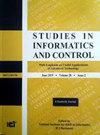Design of an Improved Interval Type-2 Controller Using FCM and Supervised Clustering Algorithms
IF 1.1
4区 计算机科学
Q4 AUTOMATION & CONTROL SYSTEMS
引用次数: 0
Abstract
: In the last few decades, the interval type-2 fuzzy controller has gained popularity in comparison with the type-1 fuzzy controller. This is due to the capability of the interval type-2 fuzzy controller to better handle uncertainty and imprecision. However, modeling an intervaltype-2 fuzzy controller brings about several hurdles. One of the challenges of the design of an interval type-2 fuzzy controller is the generation of the primary membership functions with the purpose of formulating the upper and lower membership functions. This paper proposes a technique by which two Gaussian primary membership functions are generated for an interval type-2 fuzzy set. The means for the Gaussian membership functions are generated by employing two clustering techniques, namely the standard fuzzy c-means clustering algorithm and a recently developed supervised clustering algorithm. The standard deviations of the Gaussian membership functions are optimally selected by using the differential evolution algorithm. Besides, the number of rules required for the proposed model is much smaller. The proposed controller is applied to an armature-controlled DC motor and the obtained simulation results are compared with those obtained for the conventional interval type-2 fuzzy controller. The robustness of the proposed controller is also checked by adding noise and an impulse disturbance during the simulation.基于FCM和监督聚类算法的改进区间2型控制器设计
本文章由计算机程序翻译,如有差异,请以英文原文为准。
求助全文
约1分钟内获得全文
求助全文
来源期刊

Studies in Informatics and Control
AUTOMATION & CONTROL SYSTEMS-OPERATIONS RESEARCH & MANAGEMENT SCIENCE
CiteScore
2.70
自引率
25.00%
发文量
34
审稿时长
>12 weeks
期刊介绍:
Studies in Informatics and Control journal provides important perspectives on topics relevant to Information Technology, with an emphasis on useful applications in the most important areas of IT.
This journal is aimed at advanced practitioners and researchers in the field of IT and welcomes original contributions from scholars and professionals worldwide.
SIC is published both in print and online by the National Institute for R&D in Informatics, ICI Bucharest. Abstracts, full text and graphics of all articles in the online version of SIC are identical to the print version of the Journal.
 求助内容:
求助内容: 应助结果提醒方式:
应助结果提醒方式:


